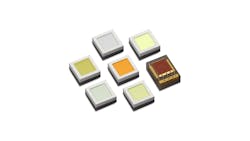Packaged LED news: Lumileds Rubix, Bridgelux F90, and Luminus IR
Lumileds has announced an addition to its Luxeon Rubix family of1414 color LEDs with new lime and amber components that add to the spectral possibilities in multi-channel entertainment and architectural or façade lighting, while also generating improved white-light spectral power distribution (SPD). Bridgelux has announced the F90 Series of white LEDs that use a phosphor formulation originally developed at GE that enables better color rendering in solid-state lighting (SSL) products without an efficacy penalty. Luminus Devices has added to its infrared (IR) LED portfolio designed for coupling to fiberoptics and intended to compete with VCSEL (vertical cavity surface-emitting laser) components.
Rubix components
Lumileds brought the 1.4×1.4-mm family to market back last August targeting entertainment applications along with automotive and even industrial applications. The initial launch included monochromatic red, green, blue, and royal blue LEDs along with a phosphor-converted white LED. The new additions will boost the potential colors produced by multi-channel SSL systems and enable a high-quality white mixed from just color components.
“The addition of Lime and PC Amber create opportunities to boost CRI, brightness, and efficacy,” said LP Liew, product marketing manager at Lumileds. “Objects will often appear more vivid when Lime is used instead of white [red, green, blue, lime 4-channel systems compared to red, green, blue, white]. With Lime and PC Amber, achieving 90+CRI at 3000K, 4000K, or 5000K is no problem and in a 6-channel solution, 95+ CRI is possible.”
Lumileds followed a similar strategy in the Luxeon C and CZ portfolios with an announcement last November. Both of the new LEDs are phosphor-converted designs. Lumileds, however, refers to the lime LED just as Lime. It calls the amber LED PC Amber because in some of its LED families it offers both monochromatic and phosphor-converted options.
The benefits of the new components can be easily seen in some graphs created by Lumileds and distribution partner Future Electronics that are shown nearby. The PC Amber delivers 250 lm and the Lime 510 lm at 1.5A.
Red-line phosphor
Moving to Bridgelux, we covered the company’s F90 LED announcement in our Company Newsfeed section of the website, but upon further scrutiny the announcement deserves additional discussion. Apparently, there is now another source for LEDs equipped with the potassium fluorosilicate (PFS) red phosphor that was originally developed in the GE Lighting organization when it was a part of GE; that intellectual property (IP) passed to GE Current when the organization was sold to American Industrial Partners (AIP). The Bridgelux announcement referred to the company as Current Lighting Solutions LLC, which evidently is the legal name of the company.
We have written a lot about the PFS or what has been called red-line phosphor over the years. The phosphor has a very narrow emission band and therefore does not waste energy outside the human visual range. For years, only GE Current used the technology in general lighting products under the TriGain brand, with Nichia making those LEDs for GE Current. Last fall, the companies struck a deal enabling other SSL manufacturers to buy PFS-based LEDs from Nichia, and now Bridgelux will also be a source of the technology.
Bridgelux will offer mid-power-type LEDs using the phosphor in 2835 and 3030 packages. “By incorporating PFS phosphor to optimize emission spectrum in conjunction with our proprietary packaging technology, the F90 Series of LEDs is able to deliver both industry-leading efficacy and high CRI,” said Tim Lester, CEO at Bridgelux. “Bridgelux’s F90 product performance is the same or better than today’s CRI 80 packages.”
Luminus IR LEDs
Moving outside the human visual range, Luminus says its new CBM-90-IRD LEDs will cost less than VCSEL components, be safer in the presence of human eyes, and offer ease of system integration into a light engine. Typical applications will be industrial and machine vision systems.
The new family can deliver radiometric power of 15W and the LEDs are offered in 780-, 850-, and 940-nm versions. “Our CBM-90-IRD-780nm LED product delivers 10+W of radiometric power that can be efficiently coupled in 5–7-mm optical fiber bundles used in endoscopy and infrared light engines,” said Yves Bertic, senior director of global product marketing at Luminus. “With the growing demand for light sources capable of exciting the new biomarkers that are continuously being developed, this product line is the perfect alternative to legacy laser-based light sources.”
LEDs Magazine chief editor MAURY WRIGHT is an electronics engineer turned technology journalist, who has focused specifically on the LED & Lighting industry for the past decade.
For up-to-the-minute LED and SSL updates, why not follow us on Twitter? You’ll find curated content and commentary, as well as information on industry events, webcasts, and surveys on our LinkedIn Company Page and our Facebook page.

Maury Wright | Editor in Chief
Maury Wright is an electronics engineer turned technology journalist, who has focused specifically on the LED & Lighting industry for the past decade. Wright first wrote for LEDs Magazine as a contractor in 2010, and took over as Editor-in-Chief in 2012. He has broad experience in technology areas ranging from microprocessors to digital media to wireless networks that he gained over 30 years in the trade press. Wright has experience running global editorial operations, such as during his tenure as worldwide editorial director of EDN Magazine, and has been instrumental in launching publication websites going back to the earliest days of the Internet. Wright has won numerous industry awards, including multiple ASBPE national awards for B2B journalism excellence, and has received finalist recognition for LEDs Magazine in the FOLIO Eddie Awards. He received a BS in electrical engineering from Auburn University.







